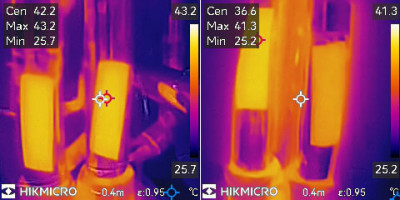Simulation of ASHP with Gas boiler as part of decision process
@cathoderay On a general note, I wonder what ball-park figure one might apply to the accuracy tolerance of the data supplied by default measuring equipment rather than by instruments installed for the purpose. My system readings are provided by the default (Daikin) equipment and the stats look very respectable; might I expect to allow perhaps + or - 10% on any given reading perhaps? Regards, Toodles.
Toodles, he heats his home with cold draughts and cooks his food with magnets.
Posted by: @toodlesI wonder what ball-park figure one might apply to the accuracy tolerance of the data supplied by default measuring equipment rather than by instruments installed for the purpose
I don't think, for my system, it is too bad, because I have some basic independent monitoring tools, and they broadly agree with the Midea data collected over modbus. For example, I calculate energy out from:
(1) Midea reported flow rate, which I can verify with an analogue flow meter installed in the circuit
(2) LWT/RWT delta t, which I can verify using an IR thermometer/camera
(3) specific heat of the circulating fluid, which is fixed for a given fluid mix
The problem is verification for (1) and (2) is based on spot readings, whereas the modbus/Midea data is continuously recorded at minute intervals. Nonetheless, a short while ago the Midea controller said the flow rate was 1.23 m^3/h (20.5l/min), while the analogue meter showed 20l/min, a ~2.5% difference, but the analogue meter has a very crude scale, maybe it was actually showing 20.5l/min. A few moments later, the delta t on both the Midea controller and the IR measurements was zero (because the heat pump is cycling, and it was in an off phase). A few minutes later, with the on phase underway, the delta t was 4 on both. Since the Midea numbers are integers, they may be a bit out, but not hugely so, and I should add that absolute values for the temps are not the same, the Midea numbers are about 3 degrees below the IR measured values eg Midea number is 38, IR number is 41, but it is not the absolute values we need, rather the difference (delta) value, which is the same. These readings (and others done in the past) are enough to satisfy me that the Midea data based calculated energy out is tolerably close to the real value, say within 5%. At least, that is what I think is the case...
Midea 14kW (for now...) ASHP heating both building and DHW
@cathoderay We are back to the person with one watch always knowing the correct time whilst the person with two watches never being quite sure.😉 Toodles.
Toodles, he heats his home with cold draughts and cooks his food with magnets.
@toodles - we are, but back to basic principles: if two independent data sources agree, or are close, then that does generally suggest that both are at least about right for what they purport to measure. There is always the possibility you have stuck the two independent sensors into the wrong orifice, and are not in fact measuring what you think you are measuring, but usually such things can be checked, though I have heard of a doctor who somehow managed to get two anatomically clearly defined orifices mixed up, until the patient, who told me the tale, mentioned to the doctor they might be barking up the wrong tree.
The other thing with the temperature measurements is they don't have to be accurate, as long as they are consistent, because it is the delta t we are after. The real temps might be 40 and 35, the measured ones 37 and 32, but in each case the delta t is the same, 5 degrees. Because I am using the same instrument to take the readings for each source (IR for the independent, whatever Midea use for the Midea data), the chances are each instrument is reasonably consistent, and so it is not unreasonable to assume it gets the delta t right, even if the absolute number is out.
Another thought: I measure the primary flow and return temps as the primary circuit enters and leaves the plate heat exchanger, mainly because it is the least awkward place to take the measurement. But strictly speaking, it they are not the LWT/RWT, which should be (and are, but the Midea sensors) measured at the heat pump. But which is more valid? It's a bit like HP at the flywheel vs HP at the road wheels on a car. Assuming losses in the flow and return pipe, the heat pump may put out X at the heat pump, but only some of X ends up delivered to the house.
I've just taken another set of temp recordings, this time capturing the IR images while noting the Midea values. The latter were LWT 38, RWT 35, and here are the IR images:
The pipes here are copper, with black insulating tape applied (the warm bars you can see) to get the emissivity at a reasonable level, primary inlet to the plate heat exchanger (and outlet from the secondary circuit) in the left hand image, primary outlet (and secondary inlet) in the right hand image. In each image, the red cross hair is on the hottest point in the image (in both cases the primary pipework), and as you can see, the primary in was 43.2 degrees, the primary out 41.3 (this red cross hair is partially obscured by the readout panel).
This time the Midea delta t was 3 (with the integer reading caveat) , the IR delta t 1.9. They may or may not be correct, but they are at least credible. This time there was a difference between the Midea and IR data, with the former being (as may perhaps be expected, see above) having the higher delta t.
The eagle eyed will also spot something else: on the left hand image, the centre cross hair (white) is very close to the max cross hair (red), yet there is a degree centigrade difference in temperature. I can't account for this, unless, and I am just thinking aloud here, it is an angular effect caused by the curve of the pipework, some of the heat misses the camera. The two red dots you can see are both on the centre of the pipe, ie perpendicular to the tangent of the pipe at that point, the point at which it 'points' most directly towards the camera.
By the way, this IR camera has already paid for itself. Not only is it very useful for heat assessments and loss detection, it is also useful among other things for monitoring things like engines and drive trains. It can probably even tell you when your bun in the oven is ready to come out, but there are probably simpler ways to do that.
Midea 14kW (for now...) ASHP heating both building and DHW
@cathoderay Your wife or the mid-wife will probably have the best idea!😳 (Sorry) Toodles.
Toodles, he heats his home with cold draughts and cooks his food with magnets.
-
UFH and ASHPs
1 month ago
-
Installing your own ASHP - DIY
2 months ago
-
ASHP install contract and BUS grant money
4 months ago
-
High air source heat pump running costs – Vaillant AroTherm Plus
4 months ago
-
Savings - using Weather Compensation & Time of Use Tariffs
4 months ago
Currently viewing this topic 1 guest.
- 22 Forums
- 2,084 Topics
- 46 K Posts
- 31 Online
- 3,377 Members
Trusted Installers
Struggling to find a reliable heat pump installer? A poor installation can lead to inefficiencies and high running costs. We now connect homeowners with top-rated installers who deliver quality work and excellent service.
✅ Verified, trusted & experienced installers
✅ Nationwide coverage expanding
✅ Special offers available
Latest Posts
-

RE: Getting the best out of a heat pump - is Homely a possible answer?
@cathoderay thanks I have just figured it out. You need...
By benson , 2 hours ago
-

RE: Renewable Heating Hub Homeowners' Q&A Podcast
@ashp-bobba thank you, and equally so, thank you for ta...
By Mars , 7 hours ago
-

@judith good to know… I’ll continue to feed Wattson, an...
By Mars , 18 hours ago
-

RE: Vaillant AroTherm Plus 7kW
@jamespa I have a hydronic baseboard heater in the kitc...
By Scalextrix , 24 hours ago
-

RE: My misgivings about installing ASHP and solar panels via the ECO4 scheme...
@editor great article re accreditation. I note ISO/IEC ...
By Bart , 1 day ago
-

RE: Renewables & Heat Pumps in the News
Here’s a little more technical detail/p>
By Judith , 2 days ago
-

RE: Who's your electricity provider and what's your tariff?
I don't (yet), but my PW3 is due to be installed shortl...
By Old_Scientist , 2 days ago
-

RE: MCS and NAPIT complaints process
@chrislay, is your heat pump complaint still unresolved...
By Mars , 2 days ago
-

RE: ASHP Install from hell - help please
@saf1973 I’ve been going through old cases on the forum...
By Mars , 2 days ago
-

RE: RDSAP10 effect on existing heat pump EPC rating?
@aaron There's the rub, the database does not list my ...
By AF1 , 3 days ago
-

RE: Commencing on an ASHP Installation Process
Yes, it's "doable" if everything goes to plan, they arr...
By Old_Scientist , 4 days ago
-

RE: How not to install a heat pump
You are right. Thinking on this has evolved over the p...
By JamesPa , 5 days ago
-

RE: DHW SET UP with Samsung gen 5
Thats good news indeed, you are very likely almost ther...
By JamesPa , 5 days ago
-

RE: Plate heat exchanger considerations
As far as I can tell my vented system would have a peak...
By Scalextrix , 5 days ago
-

RE: Air Changes per Hour - ACH and the MCS requirement
There have been a few discussions dotted around (e.g. I...
By Declan90 , 5 days ago
-

RE: Heat Pump Servicing & Maintenance – Good Value or Rip-Off?
Having made some enquiries locally I have found a compa...
By Morgan , 5 days ago





